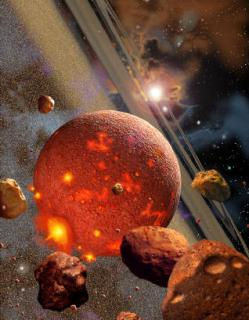 |
Formation of Earth - Ron Miller
|
Space and art seem like two quite different subjects that it is impossible to show an intersection of them. However, art in which relates with space represents that the knowledge of the universe has been discovered, understood, and conveyed by some way of art. It is amazing that people would be able to know and see what is the outer space look like from artworks which include the creations of photograph, fiction, and etc. According to the lecture video, the professor, Victoria Vesna, gave an infusive opening to briefly introduce the space where is a yearning for travel in the future; she said “we have been fascinated by the sky, the stars, the plants and we have looked at the cosmic ocean for thousands of years.” Before the age of the invention of the telescope, all the points of light in the sky attracted attention of ancient astronomers and they did a romantic thing for those stars- making Roman names of deities to call them, such as Venus which means the goddess of love and beauty. For me, this work- making names for all stars to give themselves meanings, was creative and imaginative, and it was a part of art.
 |
"The Pale Blue" dot. The rays of light are artifacts on the photo from the Sun.
-NASA
|
Owing to new technological advances, people have been able to use the telescopes to look at and observe all the shining spots in the sky, even taking photographs of them, such as “Pale Blue Dot,” a photograph of planet Earth that was taken by Voyager 1 space probe. By showing from the photo, the apparent size of Earth is less than a pixel. The planet is appearing as a tiny dot that against the vastness of space. Carl Edward Sagan, an astronomer, cosmologist and author, was impressed by this photo, and he contributed a book named “Pale Blue Dot: A Vision of the Human Future in Space.” He pointed out that on the dot, “every human being sho ever lived, lived out their lives”.

Another example is about Ron Miller, an illustrator and author specializing in science, astronomy, and science fiction, has published more than fifty books. Also, he is a production designer and an artist that he has designed postage stamps and worked on motion picture. He has ever described that the Earth actually has a ring like Saturn. And there are so many incredible photos shown on his post “If Earth Had a Ring Like Saturn.”
It is a good comprehensive topic of which combining art, science, and technology. All the beautiful works struck me and those visions give me hope for the future. Not only the photo works, but also the imagines the artists captured in ink, oils, watercolors and bytes. Importantly, all the artworks are waking dreams of us.
References:
Victoria, Vesna. "8 Space Pt1 1280x720." YouTube. YouTube, 29 July 2013. Web. 04 June 2017.
Victoria, Vesna. "Space Pt4." YouTube. YouTube, 30 May 2012. Web. 04 June 2017.
Victoria, Vesna. "Space Pt5." YouTube. YouTube, 30 May 2012. Web. 04 June 2017.
